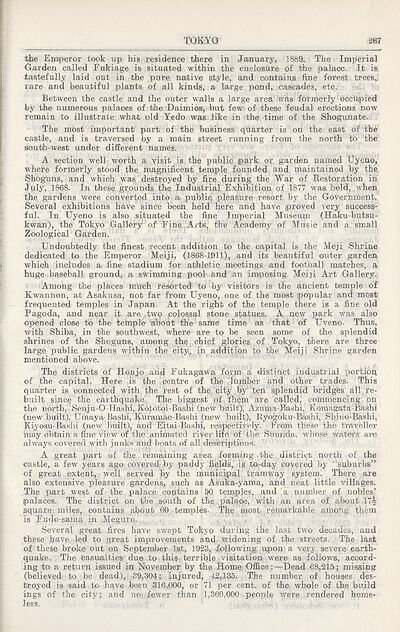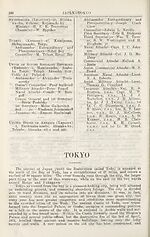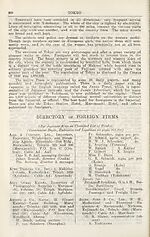1933
(323) Page 267
Download files
Complete book:
Individual page:
Thumbnail gallery: Grid view | List view

TOKYO
267
the Emiperor took up his residence there in January, 1889. The Imperial
Garden called Fukiage is situated within the enclosure of the palace. It is
tastefully laid out in the pure native style, and contains fine forest trees,:
rare and beautiful plants of all kinds, a large pond, cascades, etc.
Between the castle and the outer walls a large area was formerly occupied
by the numerous palaces of the Daimios, but few of these feudal erections now
remain to illustrate what old Yedo was like in the time of the Shogunate.
The most important part of the business quarter is on the east of the
castle, and is traversed by a main street running from the north to the
south-west under different names.
A section well worth a visit is the public park or garden named Uyeno,
where formerly stood the magnificent temple founded and maintained by the
Shoguns, and which was destroyed by fire during the War of Restoration in
July, 1868. In these grounds the Industrial Exhibition, of 1877 was held, when
the gardens were converted into a public pleasure resort by the Government.
Several exhibitions have since been held here and have proved very success¬
ful. In Uyeno is also situated the fine Imperial Museum (Haku-butsU-
kwan), the Tokyo Gallery' ofi Fine . Arts, the Academy of Music and a small
Zoological Garden.
Undoubtedly the finest recent addition to the capital is the Meji Shrine
dedicated to the Emperor Meiji, (1868-1911), and its beautiful outer garden
which includes a fine stadium for athletic meetings and football matches, a
huge baseball ground, a swimming pool and an imposing Meiji Art Gallery,
Among the places much resorted to by visitors is the ancient temple of
Kwannon, at Asakusa, not far from Uyeno, one of the most popular and most
frequented temples in Japan. At the right of the temple there is a fine old
Pagoda, and near it, are . two polossal stone statues. A new park was also
opened close to the temple about the same time as that of Uveno. Thus,
with Shiba, in the southwest, where are to be seen some of the splendid
shrines of the Shoguns, among the chief glories of Tokyo, there are three
large public gardens within the city, in addition to the Meiji Shrine garden
mentioned above.
The districts of lion jo and Fukagawa form a distinct industrial portion
of the capital. Here is the centre of the dumber and other trades. This
quarter is connected with the rest of the city by ten splendid bridges all re¬
built since the earthquake. The biggest of them’are called, commencing on
the north, Senju-O Hashi, KotOtpi-Bashi (new bbilt); Azuma-Rashi, Komagata-Bashi
(new built), Umaya-Bashi, Kuramae-Bashi (new built), Ryogoku-Bashi, Shino-Bashi,
Kiyosu-Bashi (new built), and Eitai-Bashi, respectively. From these the traveller
may obtain a fine view of the animated river life of the StuUida, whose watefs are
always covered with junks and boats of all descriptions.
A great part of the remaining area forming .the district north of the
castle, a few years ago covered by paddy fields, is to-day covered by "suburbs”
of great extent, well served by the municipal tramway system. There are
also extensive pleasure gardens, such as Asuka-yama, and neat little villages.
The part west of the palacej contains 50 temples, and a number of nobles’
palaces. The district on the’south of the palace, with an area of about 17^
square miles, contains about 60 temples. The most .remarkable among' them
is Fudo-sama in M eguro.
Several great fires have swept Tokyo during tbe last two decades, and
these have; led to great improvements and widening of the streets. The last
of these broke out on September 1st, 1923, following upon a very severe earth¬
quake. The casualties due to this; terrible visitation were as follows, accord¬
ing to a return issued in November by the Home Office:—Dead 68,215 ■ missing
(believed to be dead), 39,304; injured, 42,135. The number of houses des¬
troyed is said to have been 316,000, or 71 per cent, of the whole of the build
ings of the city; and no fewer than 1,360,000 people were rendered home¬
less. . .... ..
267
the Emiperor took up his residence there in January, 1889. The Imperial
Garden called Fukiage is situated within the enclosure of the palace. It is
tastefully laid out in the pure native style, and contains fine forest trees,:
rare and beautiful plants of all kinds, a large pond, cascades, etc.
Between the castle and the outer walls a large area was formerly occupied
by the numerous palaces of the Daimios, but few of these feudal erections now
remain to illustrate what old Yedo was like in the time of the Shogunate.
The most important part of the business quarter is on the east of the
castle, and is traversed by a main street running from the north to the
south-west under different names.
A section well worth a visit is the public park or garden named Uyeno,
where formerly stood the magnificent temple founded and maintained by the
Shoguns, and which was destroyed by fire during the War of Restoration in
July, 1868. In these grounds the Industrial Exhibition, of 1877 was held, when
the gardens were converted into a public pleasure resort by the Government.
Several exhibitions have since been held here and have proved very success¬
ful. In Uyeno is also situated the fine Imperial Museum (Haku-butsU-
kwan), the Tokyo Gallery' ofi Fine . Arts, the Academy of Music and a small
Zoological Garden.
Undoubtedly the finest recent addition to the capital is the Meji Shrine
dedicated to the Emperor Meiji, (1868-1911), and its beautiful outer garden
which includes a fine stadium for athletic meetings and football matches, a
huge baseball ground, a swimming pool and an imposing Meiji Art Gallery,
Among the places much resorted to by visitors is the ancient temple of
Kwannon, at Asakusa, not far from Uyeno, one of the most popular and most
frequented temples in Japan. At the right of the temple there is a fine old
Pagoda, and near it, are . two polossal stone statues. A new park was also
opened close to the temple about the same time as that of Uveno. Thus,
with Shiba, in the southwest, where are to be seen some of the splendid
shrines of the Shoguns, among the chief glories of Tokyo, there are three
large public gardens within the city, in addition to the Meiji Shrine garden
mentioned above.
The districts of lion jo and Fukagawa form a distinct industrial portion
of the capital. Here is the centre of the dumber and other trades. This
quarter is connected with the rest of the city by ten splendid bridges all re¬
built since the earthquake. The biggest of them’are called, commencing on
the north, Senju-O Hashi, KotOtpi-Bashi (new bbilt); Azuma-Rashi, Komagata-Bashi
(new built), Umaya-Bashi, Kuramae-Bashi (new built), Ryogoku-Bashi, Shino-Bashi,
Kiyosu-Bashi (new built), and Eitai-Bashi, respectively. From these the traveller
may obtain a fine view of the animated river life of the StuUida, whose watefs are
always covered with junks and boats of all descriptions.
A great part of the remaining area forming .the district north of the
castle, a few years ago covered by paddy fields, is to-day covered by "suburbs”
of great extent, well served by the municipal tramway system. There are
also extensive pleasure gardens, such as Asuka-yama, and neat little villages.
The part west of the palacej contains 50 temples, and a number of nobles’
palaces. The district on the’south of the palace, with an area of about 17^
square miles, contains about 60 temples. The most .remarkable among' them
is Fudo-sama in M eguro.
Several great fires have swept Tokyo during tbe last two decades, and
these have; led to great improvements and widening of the streets. The last
of these broke out on September 1st, 1923, following upon a very severe earth¬
quake. The casualties due to this; terrible visitation were as follows, accord¬
ing to a return issued in November by the Home Office:—Dead 68,215 ■ missing
(believed to be dead), 39,304; injured, 42,135. The number of houses des¬
troyed is said to have been 316,000, or 71 per cent, of the whole of the build
ings of the city; and no fewer than 1,360,000 people were rendered home¬
less. . .... ..
Set display mode to:
![]() Universal Viewer |
Universal Viewer | ![]() Mirador |
Large image | Transcription
Mirador |
Large image | Transcription
Images and transcriptions on this page, including medium image downloads, may be used under the Creative Commons Attribution 4.0 International Licence unless otherwise stated. ![]()
| Asian directories and chronicles > 1933 > (323) Page 267 |
|---|
| Permanent URL | https://digital.nls.uk/203678510 |
|---|
| Attribution and copyright: |
|
|---|---|
| Description | Volumes from the Asian 'Directory and Chronicle' series covering 1917-1941, but missing 1919 and 1923. Compiled annually from a multiplicity of local sources and research. They provide listings of each country's active corporations, foreign residents and government agencies of all nationalities for that year, together with their addresses. Content includes: various treaties; coverage of conflicts; currencies and taxes; consular fees; weights and measures; public holidays; festivals and traditions. A source of information for both Western states and communities of foreigners living in Asia. Published by Hongkong Daily Press. |
|---|---|
| Shelfmark | H3.86.1303 |
| Additional NLS resources: |

